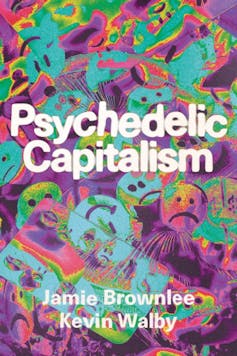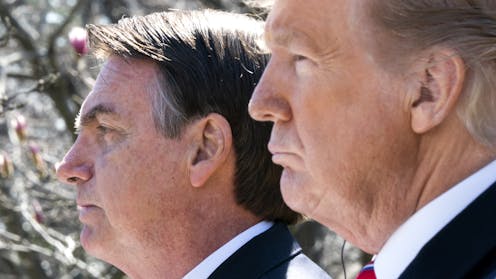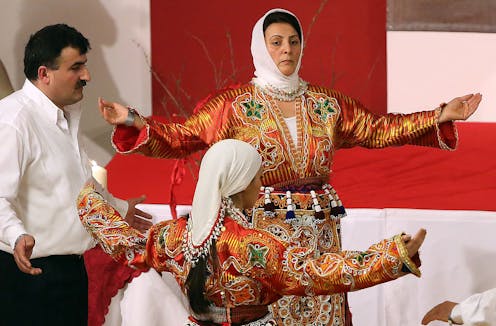Source: The Conversation – in French – By Kevin Walby, Professor of Criminal Justice, University of Winnipeg
Autrefois stigmatisés et interdits, les psychédéliques sont passés de la contre-culture à la culture dominante. De l’utilisation de la psilocybine par le prince Harry aux aventures du quart-arrière (quarterback) de la Ligue nationale de football américain Aaron Rodgers avec l’ayahuasca, nos médias regorgent de témoignages vantant leurs bienfaits.
Des centaines d’universités à travers le monde se lancent désormais dans la recherche sur les psychédéliques. Et des initiatives de légalisation prennent forme.
Les psychédéliques sont en train de devenir un marché très lucratif. Tout comme le capital privé a inondé le secteur du cannabis il y a quelques années, une nouvelle ruée vers l’or est en cours, cette fois autour des psychédéliques.
De riches entrepreneurs investissent dans l’industrie psychédélique tandis que des start-up biotechnologiques lèvent des fonds et mènent des essais cliniques sur de nouvelles molécules psychédéliques. Les investisseurs en capital-risque convoitent les perspectives offertes par un nouveau marché de masse lucratif.
À lire aussi :
Et si les drogues psychédéliques pouvaient révolutionner votre fin de vie?

(Fernwood)
Trois sujets de préoccupation
À ce jour, la plupart des débats sur les psychédéliques ont peu analysé de manière critique leur relation avec l’économie politique du capitalisme moderne et les structures de pouvoir au sens large. Dans notre nouveau livre Psychedelic Capitalism, nous formulons trois constats sur ce que l’on appelle la renaissance psychédélique.
Premièrement, la médicalisation des psychédéliques risque de restreindre leur accès et de renforcer les inégalités sanitaires et sociales existantes.
Deuxièmement, la « corporatisation » des psychédéliques permettra aux élites économiques de dominer le marché tout en s’appropriant le vaste réservoir de connaissances accumulées par les communautés autochtones, les institutions publiques et les chercheurs clandestins.
Déjà des milliers d’abonnés à l’infolettre de La Conversation. Et vous ? Abonnez-vous gratuitement à notre infolettre pour mieux comprendre les grands enjeux contemporains.
Et troisièmement, plutôt que de représenter une réforme progressiste en matière de drogues, la légalisation limitée de certains psychédéliques à des fins médicales contribuera à renforcer et à pérenniser la guerre contre la drogue et la criminalisation de sa consommation.
Ignorer les connaissances communautaires
Partout en Amérique du Nord, nous assistons à une médicalisation des psychédéliques. De nombreux problèmes sont présentés comme pouvant être traités par ces substances. Cela se fait d’une manière qui renforce le contrôle des entreprises sur le processus et met de côté les connaissances communautaires et autochtones.
Nous avons vu ce phénomène en Australie. Certaines substances comme la psilocybine et la MDMA sont désormais légales, mais uniquement sur ordonnance médicale et à un coût financier élevé, ce qui soulève des questions sur l’équité, l’accès et les destinataires de ces thérapies.
Le fait de présenter les psychédéliques comme des produits pharmaceutiques et des solutions de santé individualisées renforce le discours prohibitionniste selon lequel ces substances ne sont pas adaptées à une utilisation en dehors du contexte médical. Ce discours détourne l’attention de la manière dont l’utilisation médicalisée pourrait perpétuer une idéologie néolibérale, qui réduit les troubles mentaux à des problèmes individuels plutôt que de s’attaquer aux causes plus systémiques telles que la pauvreté, les inégalités et l’exclusion sociale.
Il ignore également des siècles de traditions créées par l’usage communautaire autochtone, ainsi que les valeurs de la culture psychédélique underground.
Un système fondé sur des thérapies individuelles coûteuses et un accès clinique hypercontrôlé n’est pas le modèle envisagé par la plupart des défenseurs.
Un modèle basé uniquement sur la pilule pour la productivité et le bonheur
Les fondements du capitalisme psychédélique ont été largement créés par l’innovation publique aux frais du contribuable et sont aujourd’hui en train d’être repris par le capital privé.
Les conférences sur les psychédéliques prennent de plus en plus l’allure de salons commerciaux. L’industrie du tourisme psychédélique continue de se développer et de s’adresser à une clientèle élitiste. Des entreprises à but lucratif telles que Mind Medicine et Compass Pathways éliminent la psychothérapie de leurs protocoles de traitement et adoptent un modèle strictement médicamenteux, privilégié par les grandes entreprises pharmaceutiques.
Les psychédéliques, y compris le microdosage et la thérapie assistée par psychédéliques, sont commercialisés comme un moyen pour la population générale d’améliorer leur productivité dans une vie déjà surchargée, tout en y trouvant du bonheur.
Les entreprises se font concurrence pour s’approprier la propriété intellectuelle afin de tirer profit des composés existants et d’ériger des barrières juridiques autour des nouvelles substances chimiques et de leurs applications.
L’industrie lucrative de la kétamine offre déjà un aperçu de l’avenir de la thérapie psychédélique commercialisée. Cela inclut une négligence des risques, un marketing trompeur et peu de considération pour les soins thérapeutiques.
Il y a eu une vague de nouvelles demandes de brevets (et de brevets accordés) aux États-Unis sur des substances telles que la psilocybine, le LSD, le DMT, le 5-MeO DMT et la mescaline, qui visent à garantir l’exclusivité, à monopoliser les chaînes d’approvisionnement et à privatiser des connaissances qui existent déjà dans le domaine public.
Les psychédéliques ont été intégrés dans les logiques bien établies du capitalisme, où des acteurs privés s’approprient des droits exclusifs sur ce qui est en fin de compte le fruit de la lutte collective de l’humanité et de ses réalisations intellectuelles.
Légalisation médicale des psychédéliques
L’approche médicalisée des psychédéliques est également liée à la législation et à la politique en matière de drogues.
En Amérique du Nord, l’approche biomédicale la principale voie d’accès aux psychédéliques dans la plupart des juridictions. Cette approche est largement soutenue par l’industrie des psychédéliques qui ont un intérêt financier dans la légalisation médicale et souhaitent limiter l’accès légal à tout ce qui ne relève pas du cadre médico-pharmaceutique.
Aux États-Unis, des États comme l’Oregon et le Colorado ont adopté des modèles juridiques plus holistiques qui incluent des éléments de contrôle communautaire afin d’empêcher la mainmise des entreprises. Mais la plupart des initiatives étatiques restent limitées dans leur portée et sont centrées sur les thérapies médicalisées, en particulier pour les anciens combattants. Même dans l’Oregon, qui a été salué pour ses politiques progressistes en matière de drogues, on observe une nette tendance à la médicalisation.
L’industrie canadienne du cannabis illustre parfaitement comment les processus de légalisation peuvent s’entremêler avec les intérêts des industries dominées par les grandes entreprises.
Comme l’explique Michael Devillaer, professeur de psychiatrie et de neurosciences comportementales et auteur de Buzz Kill (2024), l’industrie du cannabis a donné la priorité à la maximisation des profits, à la promotion des produits et à l’augmentation de la consommation au détriment des préoccupations de santé publique.
À lire aussi :
Légalisation du cannabis par le Canada et modèle québécois : quels constats ?
Qu’est-ce qui est le mieux pour l’intérêt public ?
À mesure que la légalisation médicale des psychédéliques s’accroit, nous assisterons probablement à un durcissement des sanctions pénales pour les usages récréatifs et autres.
En effet, les saisies policières de psychédéliques tels que la psilocybine ont augmenté ces dernières années aux États-Unis. Les arrestations pour le transport de composés tels que l’ayahuasca, l’iboga et le peyotl ont également augmenté dans le monde.
Ces problèmes risquent d’être exacerbés par les systèmes de classification bifurquée, dans lesquels un produit pharmaceutique est classé dans une catégorie différente de celle de son principe actif ou de sa substance.
Par exemple, si la Food and Drug Administration (FDA) américaine autorisait la psilocybine pour traiter la dépression ou la MDMA pour traiter le syndrome de stress post-traumatique, il est probable que seuls les produits médicinaux à base de psilocybine et de MDMA approuvés par la FDA seraient reclassés, tandis que les substances elles-mêmes continueraient d’être interdites en tant que stupéfiants soumis à restriction.
Il est dans l’intérêt public de dépasser une vision étroite de la légalisation médicale pour adopter un modèle plus ouvert et dépénalisé d’accès public. Une telle approche permettrait non seulement d’atténuer les menaces liées à la mainmise des entreprises, mais aussi de réduire les méfaits associés à la criminalisation et à la guerre contre la drogue.
La dépénalisation contrôlée par la communauté est une meilleure voie pour intégrer les psychédéliques dans la société que de céder le pouvoir à l’industrie médicale et aux cartels pharmaceutiques qui fournissent des services monopolistiques à une clientèle principalement aisée.
Et le fait de traiter la consommation de drogues et la dépendance comme une question de santé publique et d’encourager la réduction des risques et les services de soutien aux populations à risque contribueraient grandement à atténuer les tragédies de la guerre contre la drogue.
![]()
Les auteurs ne travaillent pas, ne conseillent pas, ne possèdent pas de parts, ne reçoivent pas de fonds d’une organisation qui pourrait tirer profit de cet article, et n’ont déclaré aucune autre affiliation que leur organisme de recherche.
– ref. Les psychédéliques sont détournées de leur usage traditionnel par l’industrie médicale, et ce n’est pas pour le mieux – https://theconversation.com/les-psychedeliques-sont-detournees-de-leur-usage-traditionnel-par-lindustrie-medicale-et-ce-nest-pas-pour-le-mieux-260744







